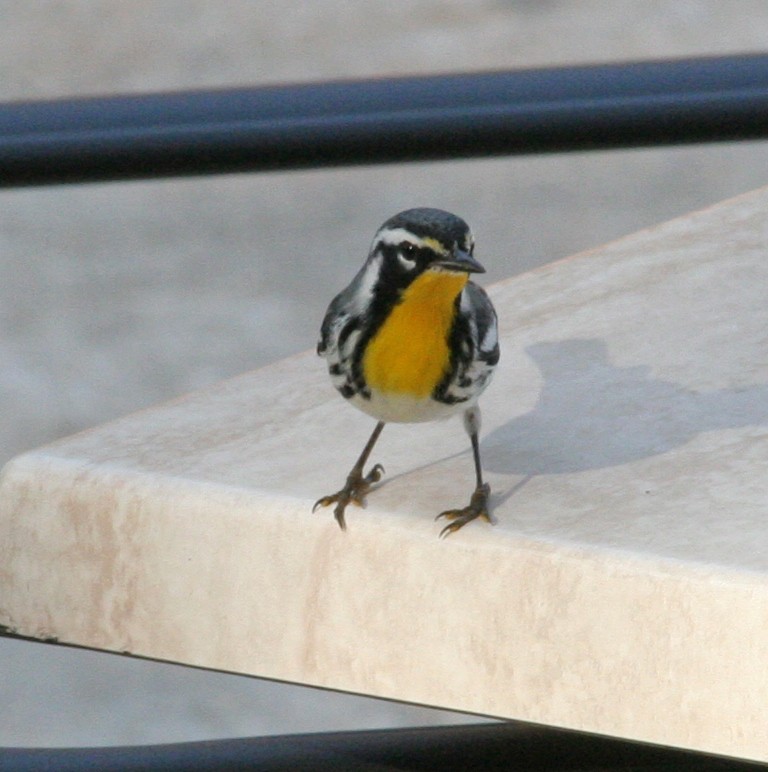Yellow-throated Warbler
A species of Setophaga Warblers, Also known as Sycamore Warbler Scientific name : Setophaga dominica Genus : Setophaga Warblers
Yellow-throated Warbler, A species of Setophaga Warblers
Also known as:
Sycamore Warbler
Botanical name: Setophaga dominica
Genus: Setophaga Warblers
Content
Description People often ask General Info
Description
In summer, male yellow-throated warblers display grey upperparts and wings, with double white wing bars. Their throats are yellow, and the remainder of their underparts are white, and are streaked with black on the flanks. Their heads are strongly patterned in black and white, with a long supercilium; the different subspecies may display yellow and white superciliums. Remiges and rectrices are black. They measure 14 cm (5.5 in) long. Other plumages of these birds – females immatures and non-breeding males – resemble washed-out versions of the summer males; in particular they have a less crisply defined strong head pattern. They also have less bright yellows, and dark grey feathers instead of black ones in the body plumage. Compared to many other New World warblers, sexual dimorphism is slight however. The males' songs are clear, descending whistles. The calls are high sees or sharp chips. Measurements: Length: 5.1-5.5 in (13-14 cm) Weight: 0.3-0.4 oz (9-11 g) Wingspan: 8.3 in (21 cm) 
Size
13 cm (5.25 in)
Colors
Black
Yellow
Gray
White
Life Expectancy
5 years
Nest Placement
Tree
Clutch Size
3 - 5 eggs
Number of Broods
12 - 13 days
Feeding Habits
Yellow-throated Warbler predominantly consumes various insects, including beetles, caterpillars, flies, and scale insects. Yellow-throated Warbler's feeding behavior involves creeping up branches in the canopy and probing into crevices, pine cones, and needle clusters for prey. In the nonbreeding season, yellow-throated Warbler also feeds on insects around agave and coconut palm flowers.
Habitat
Yellow-throated Warbler typically resides in open woodlands and groves, showing a strong preference for areas dominated by live oaks, pines, and sycamores. These birds thrive at various elevations within pine forests characterized by sparse understories, as well as bald cypress swamps and streamside woodlands, which provide optimal breeding environments. The climate is generally warm and humid, aligning with their affinity for Southern and Midwestern United States habitats. In non-breeding seasons, yellow-throated Warbler adapts to second-growth woodlands, urban parks, and gardens.
Nest Behavior
Yellow-throated Warbler typically nests in mature forest canopies, with females constructing the nest and lining it with soft materials. Building occurs near branch edges or within Spanish moss. The timing of nest building, egg-laying patterns, and parental care specifics are in line with typical warbler species, with both parents involved in offspring care.
Nest Characteristics
The yellow-throated Warbler's nest is typically found in the canopy of mature forests, often on the edges of branches or within Spanish moss. The nests are cup-shaped, made from bark strips, grasses, weeds, moss strands, and lined with plant down and feathers. Unique to its preference for Spanish moss, the yellow-throated Warbler creates a pocket in the moss, integrating it into the nest structure.
Dite type
Insectivorous
People often ask
General Info
Feeding Habits
Bird food type
Bird Feeder Type

Platform
Sounds
Song
Recording location: United States
Song
Recording location: United States
Behavior
Yellow-throated Warbler are adept climbers, often navigating up branches in a manner reminiscent of Brown Creepers or Black-and-white Warblers. They exhibit a methodical foraging style, distinct from the flitting movements typical of other warblers, as they meticulously inspect crevices, pine cones, and needles for insects. Territory establishment by males is achieved through song during the breeding season, and these males tend to interact solely with their mate and offspring. In contrast, the nonbreeding season sees yellow-throated Warbler forming mixed-species groups alongside Carolina Chickadees, Tufted Titmice, and fellow warblers, underscoring their sociable nature outside the breeding period.
Species Status
Not globally threatened.
Scientific Classification
Phylum
Chordates Class
Birds Order
Perching birds Family
New world warblers Genus
Setophaga Warblers Species
Yellow-throated Warbler 